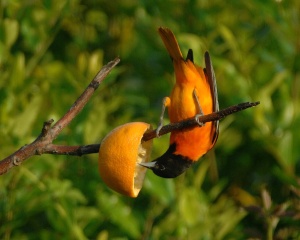by Kay Charter – As you read this, Neotropical songbirds are in the midst of migrating back their to breeding grounds in North America. Among those species on the move is the brilliant and beautiful Baltimore Oriole. This bright orange and black bird nests across the northeastern U. S. and south central Canada. Orioles may visit your yard in transit, or if you have the right habitat, you may be lucky enough to host a nesting pair.
During the past several decades, offering jelly to these bright orange and black birds has become increasingly popular. I confess that I have had a prejudice against this practice from the time I first saw it years ago in a relative’s yard. It just didn’t look right. So I did some research. What I learned reinforced my sense that isn’t right for birds. A good friend, an internist, said that high sugar foods very likely trigger a bird’s satiety gland, much as it does in a human, causing it to feel satisfied even though it has ingested nothing of nutritional value. Imagine giving a child a bag of Skittles before dinner. After devouring a bag of candy, would that child then sit down at the table and eat a meal with much needed nutrients?
My friend added that sugar may be as addictive for birds as it is for humans. Orioles are frugivores, which means that fruit and nectar constitute a significant percentage of their diets. Fruits and natural nectars contain up to 30 percent sugars, while jellies have more than twice that amount. Also, some jellies contain artificial colors or chemical preservatives, both of which may be deleterious to birds.
Kent Mahaffey was manager of the San Diego Wild Animal Park’s famous free-flight Bird Show for more than two decades. In that role, Kent had primary care responsibility for hundreds of birds from many families. He said he would never allow any birds under his care to have jelly. He added, “In general, any food that exceeds the balance of sucrose in a bird’s natural diet is suspect. Natural nectars contain 12% to 30% sugars, while jams and jellies are more than half sugar.”
Kent said that higher than normal sugar loads may outstrip a bird’s ability to adequately process sugar (as it does in humans); and products high in sugars create an ideal environment for bacterial growth. “Birds developed the way they did by adapting to the environments in which they lived and the foods that sustained them,” he said. “We do our best for them when we stick as closely as possible to their natural diets.”
People offer jelly to orioles because they love it, but there is no way to check the effect of high sugar products on the internal organs of wild birds, or, as Kent suggested, bacterial growth. The wise path is to stick with his suggestion: Offer foods to birds that are as close as possible to those in their natural diets.”
(Saving Birds recommends a natural alternative: Offer grapes or oranges. Birds love them, and they have nutrients essential to their health.)
Kay Charter is Executive Director of Saving Birds Thru Habitat and co-owner of Charter Sanctuary for breeding and migrating birds. She also sits on the Kirtland’s Warbler Alliance committee.




April 20, 2014
Conservation Education, Wildlife